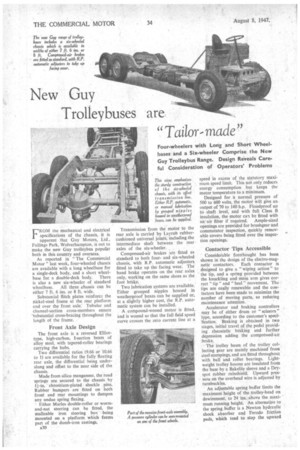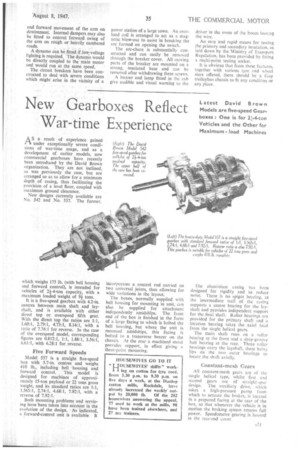New Guy Trolleybuses are
Page 32

Page 33

If you've noticed an error in this article please click here to report it so we can fix it.
"Tailor-made"
Four-wheelers with Long and Short Wheelbases and a Six-wheeler Comprise the New Guy Trolleybus Range. Design Reveals Careful Consideration of Operators' Problems
FROM me mechanical and electrical specifications of the chassis, it is apparent that Guy Motors, Ltd., Fallings Park, Wolverhampton, is out to make the new Guy trolleybus popular both in this country and overseas.
As reported in "The Commercial Motor" last week, four-wheeled chassis are available with a long wheelbase fur a single-dock body, and a short wheelbase for a double-deck body. There is also a new six-wheeler of standard
wheelbase. All three chassis can be either 7 ft. 6 ins. or 8 ft. wide. Substantial flitch plates reinforce the nickel-steel frame at the rear platform and over the front axle. Tubular and channel-section cross-members ensure -Rubstantial cross-bracing throughout the length of the frame.
Front Axle Design The front axle is a reversed Elliottype, high-carbon, I-section beam of alloy steel, with tapered-roller bearings carrying the hubs.
Two differential ratios (9.66 or 10.66 to 1) are available for the fully floating rear axle, the differential being underslung and offset to the near side of the chassis.
Made from silico manganese, the road springs are secured to the chassis by chromium-plated shackle pins. Rubber bumpers are fitted on both front and rear mountings to dampen any undue spring flexing.
• Either Manes double-roller or wormand-nut steering can be fitted, the malleable iron steering box being mounted on a platform which forms part of the dumb-iron castings.
A30 Transmission from the motor to the rear axle is carried by Layrub rubbercushioned universal joints, including the intermediate shaft between the rear axles of the six-wheeler.
Compressed-air brakes are fitted as standard to both fourand six-wheeled chassis, with R.P. automatic adjusters fitted to take up the facing wear. The hand brake operates on the rear axles only, working on the same shoes as the foot brake.
Two lubrication systems are available. Either grouped nipples housed in weatherproof boxes can be supplied or, at a slightly higher cost, the R.P. automatic system can be installed.
A compound-wound motor is fitted, and is wound so that the full field speed curve crosses the zero current line at a speed in excess of the statutory maximum speed limit. This not only reduces energy consumption but keeps the motor temperature to a minimum.
Designed for a normal pressure of 500 to 600 volts, the motor will give an output of 70 to 140 h.p. Floodproof up to shaft level, and with full Class B insulation, the motor cal be fitted with an air filter if required. Ample-sized openings are provided for brushgear and commutator inspection, quickly removable covers being fitted over the inspection openings.
Contactor Tips Accessible
Considerable forethought has been shown in the design of the electro-magnetic contactors. Each contactor is designed to give a "wiping action" to the tip, and a spring provided between the knuckling and main arm gives correct " tip " and " heel " movement. The tips are easily renewable and the contactors have been made to minimize the number of moving parts, so reducing maintenance attention.
Accelerator and braking controllers may be of either drum or " scissors " type, according to the customer's specification. Braking is obtained in two stages, initial travel of the pedal providing rheostatic braking and further depression adding the compressed-air brake.
The trolley bases of the trolley collecting gear are mainly machined from steel stampings, and are fitted throughout with ball and roller bearings. Lightweight trolley booms are insulated from the base by a Bakelite sleeve and a Dryspot rubber rainshield. Upward pressure on the overhead wire is adjusted by turnbuckles.
An adjustable spring buffer limits the maximum height of the trolley-head on dewirement, to 24 ins, above the maximum running height. An alternative to the spring buffer is a Newton hydraulic shock absorber and Ferodo friction pads, which tend to stop the upward and forward movement of the arm on dewirement. Internal dampers may also he fitted to control forward swing of the arm on rough or heavily cambered roads.
A dynamo can be fitted if low-voltage lighting is required. The dynamo would he directly coupled to the main motor and would run at the same Epeed.
The circuit breakers have been constructed to deal with severe conditions which might arise in the vicinity of a
power station of a large town. An overload coil is arranged to act as a magnetic blow-out. to-assist in breaking the arc formed on opening the switch.
The are-chute is substantially constructed and can easily be removed through the breaker cover. All moving parts of the breaker are mounted on a strong, insulated base and can be removed after withdrawing three screws.
A buzzer and lamp fitted in the cab give audible and visual warning to the
driver in the event of the boom leaving the wire.
An easy and rapid means for testing the primary and secondary insulation, as laid down by the Ministry of Transport Regulation, has been provided by fitting a multi-point testing socket.
It is obvious that from these features, together with various tyre and wheel sizes offered, there should be a Guy trolleybus chassis to fit any condition or any place..












































































